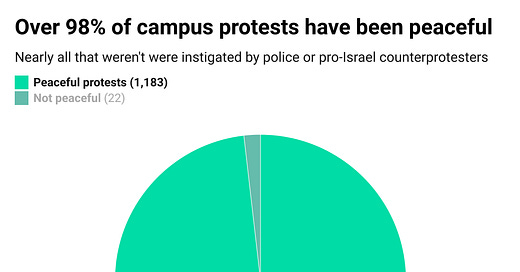More than 98 percent of the campus protests have been peaceful
Polygraph | Newsletter n°255 | 22 June 2024
*Thank you Tim C. for becoming Polygraph’s latest paid subscriber!
*Paid subscribers saw my last post on how the Biden administration tried to make the Gaza pier look like less of dumpster fire by changing how they measured aid: https://stephensemler.substack.com/p/pier-one-imports-how-much-gaza-aid
*Last announcement: You know the tide is finally turning against the pier when you see my name in a NYT article about it:
Situation
Both Joe and Jill Biden say the campus protesters are violent, but more than 98 percent of the Gaza protests at US colleges and universities have been peaceful. Most of the ones that weren’t peaceful were because of police or pro-Israel counterprotesters.
I looked at 1,205 US campus protests between October 7 and May 24. These were recorded and coded by the Armed Conflict Location & Event Data Project (ACLED), which collects data on “all reported political violence and protest events around the world.”
The Guardian featured ACLED’s data last month to show that 97 percent of the campus demonstrations from April 18 to May 3 were peaceful. I bothered doing my own analysis because I wanted the largest sample size possible and a closer look at the protests ACLED coded as “violent demonstrations.”
Violent demonstrations
Only 22 of the 1205 campus protests were coded as “violent demonstrations.”1 This number refers to when the protesters themselves behaved violently (toward other humans or property). If it included cases where police and pro-Israel counterprotesters sought out and harmed the protesters, the number would be much higher.
Police intervened in campus protests 135 times. In 121 of them,2 the protests weren’t categorized as “violent demonstrations” even when police used violence against protesters. So police storming an encampment, shooting protesters with rubber bullets, and making mass arrests didn’t qualify as a “violent demonstration” unless some protesters decided to forcefully resist.3
A key takeaway: Campus protesters were far more likely to demonstrate restraint than commit violence, even if someone was being violent toward them.
Another key takeaway: Campus protests pretty much only became violent after counterprotesters or the police showed up.
Without either of those parties imposing themselves on the protesters, I found just two instances of violent demonstrations, and the violence was directed at inanimate objects (computers, windows, etc). In one of those cases, police later arrived and inflicted far more harm on the students than the students did to the windows (see police raid on Hind’s Hall, Columbia University, April 30).
In most of the other 20 cases, the violence from protesters appeared either to be in self-defense or vastly outweighed by the violence directed at them. Granted, this is based on my reading ACLED’s description of each incident, which are only a paragraph or two long. But here are a couple examples of what I’m talking about (emphasis/ellipses mine):
-On 30 April 2024, pro-Palestinian demonstrators continued their encampment at Dickson Plaza at UCLA … Shortly before midnight, around 100 pro-Israel counter-demonstrators wearing black outfits and white masks removed barriers separating the two demonstrations, attempted to tear down the encampment, and attacked the demonstrators, throwing fireworks, tear gas, and debris into the encampment, spraying chemicals at demonstrators, beating up a student journalist and an editor with the Daily Bruin, striking demonstrators with wooden slabs, and yelling anti-Palestinian and anti-African American slurs … Pro-Palestine demonstrators fought to keep counter-demonstrators away from their barricades … UC Divest said 25 demonstrators were taken to the hospital after the attack.
-On 30 April 2024, 80-some pro-Palestinian demonstrators encamped at the Main Gate at the University of Arizona in Tucson … Late in the night, dozens of police in riot gear stormed the encampment firing rubber bullets, tear gas, and pepper balls to disperse the encampment. Students threw water bottles and pushed back against the police line.
^Alt text for screen readers: Over 98 percent of campus protests have been peaceful. Nearly all that weren’t were instigated by police or pro-Israel counterprotesters. This pie chart displays 1,183 peaceful protests and 22 not-peaceful protests in two shades of green. Figures refer to US campus protests over Gaza, 7 Oct 2023 to 24 May 2024, via author analysis of Armed Conflict Location and event Data Project (acleddata dot com) data, accessed 30 May 2024.
SPECIAL THANKS TO: Alan F., Andrew R., Bart B., BeepBoop, Bill S., Byron D., Chris G., David S.,* David V.,* Francis M., Irene B., Gary W., George C., Jcowens004, Jerry S., John A., Joseph B., Kheng L., Linda B., Lora L., Marie R., Mark G., Matthew H.,* Megan., Meghan W., Nick B., Omar D.,* Peter M., Philip L., Rosemary K., Silversurfer7, Springseep, Theresa A., Themadking724, Tim C., Tony L., Tony T.
* = founding member
-Stephen (Follow me on Instagram, Twitter, and Bluesky)
I removed one categorized as violent because it didn’t appear to be on campus or involve any students. Case description: “On 1 May 2024, about 60 pro-Palestinian people marched to VCU Police Headquarters in Richmond...”
ACLED coded one instance of “excessive force against protesters” which I included in this figure.
See, for example, video of the police raid at UCLA on May 1, which showed police storming the encampment in the middle of the night, firing rubber bullets at demonstrators. Five protesters were reportedly hit in the head. ACLED did not code this as a violent demonstration.





